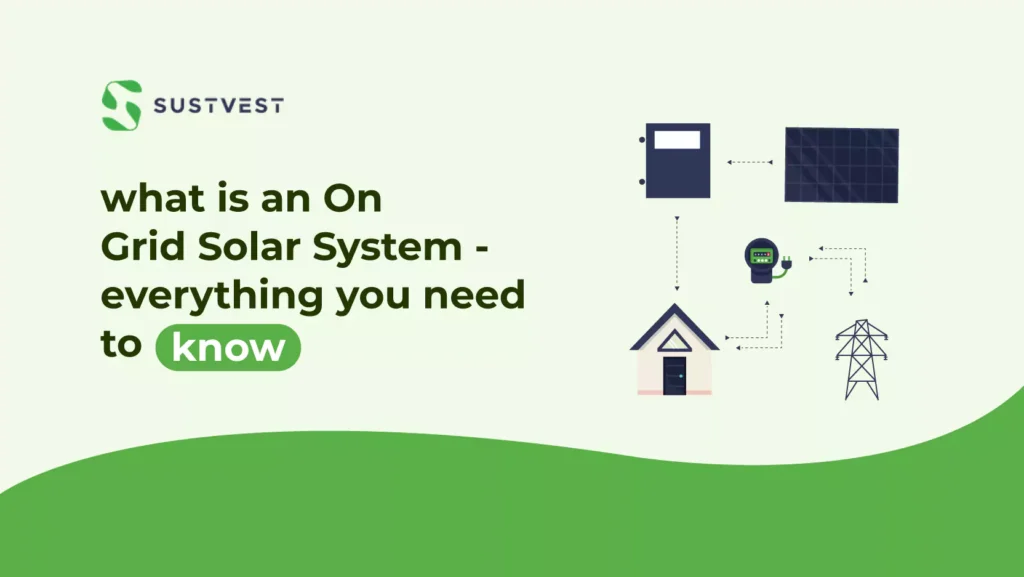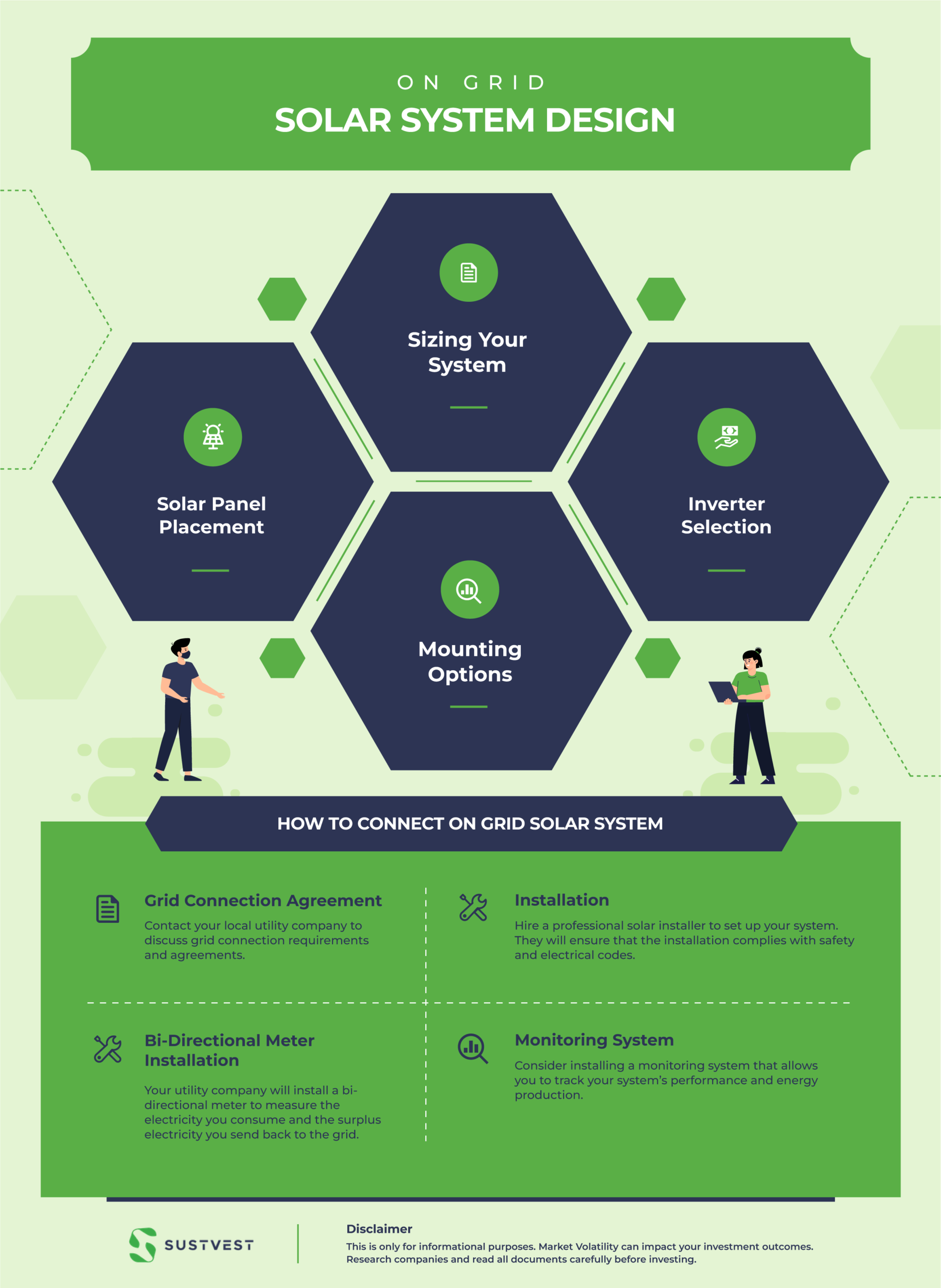Solar energy is revolutionizing electricity generation, providing homeowners with sustainable and economical alternatives. You must know how to invest in solar projects to generate income from solar projects. From the multitude of available options, on-grid solar systems have risen to prominence as a preferred choice. In this extensive guide, we will thoroughly explore what is an on grid solar system and its advantages.

What is an On Grid Solar System?
If you are wondering what is an On Grid Solar System, it is referred to as a grid-tied or grid-connected solar system. It’s a solar power setup that’s linked to your local utility grid directly. With this arrangement, solar panels positioned on a rooftop or at a designated location harness sunlight to produce electricity.
How Does a Grid-Tied Solar System Work?
At the heart of every on-grid solar system lies a fascinating process that converts sunlight into electricity, providing an eco-friendly and acts as an Off Grid or On Grid Solar System for home.
Transforming Sunlight into Electricity
Upon sunlight reaching the solar panels, a remarkable process unfolds within the photovoltaic cells, known as the photovoltaic effect. This intricate phenomenon converts sunlight into direct current (DC) electricity. However, homes and most appliances operate on alternating current (AC).
Powering Your Home and Contributing to the Grid
The AC electricity generated by the inverter serves as a power source for your home’s electrical demands. Any surplus electricity is seamlessly routed back to the grid through the assistance of a bi-directional meter. This dual function ensures that your energy needs are met while also contributing to the stability and availability of power for the wider grid.
Powering Your Home and the Grid
This surplus power benefits you in two ways: Reducing Your Electricity Bills: By sending excess electricity to the grid, you earn credits on your utility bill, effectively lowering your monthly expenses.
Supporting the Grid: Your contribution helps stabilize the grid and ensures a more reliable power supply for everyone.
Considerations Before Going On Grid
While on-grid solar systems offer numerous benefits, there are a few factors to consider:
1.Location: Your location plays a crucial role in harnessing solar energy effectively. Ensure your area receives an adequate amount of sunlight throughout the year.
2.Initial Investment: While there are subsidies available (we’ll discuss this later), installing an on-grid system does require an upfront investment.
3.Grid Compatibility: Check with your local utility company to ensure that your grid is compatible with on-grid systems.
On Grid Solar System Design
Designing an efficient on-grid solar system is essential to maximize its benefits. Here are key design considerations:
1.Sizing Your System
Determining the appropriate system size is crucial. Factors like your electricity consumption, location, and available roof space influence the size of your solar array.
2.Solar Panel Placement
Solar panels should be strategically placed to receive maximum sunlight. Factors like shading and orientation need to be considered during installation.
3.Inverter Selection
You must understand what is an On Grid Solar System before choosing the right inverter. String inverters are common for smaller installations, while microinverters offer advantages for complex roof designs or shaded areas.
4.Mounting Options
The mounting system should be sturdy and compatible with your roof type. Common options include roof mounts, ground mounts, and tracking mounts.

On Grid Solar System Subsidy
Many states provide incentives, such as grants, and property tax exemptions, to promote solar adoption.
Net Metering
Net metering policies vary by location but generally allow you to earn credits for excess electricity you feed back into the grid.
How to Connect On Grid Solar System
The connection involves a few essential steps:
1.Grid Connection Agreement
Contact your local utility company to discuss grid connection requirements and agreements.
2.Installation
Hire a professional solar installer to set up your system. They will ensure that the installation complies with safety and electrical codes.
3.Bi-Directional Meter Installation
Your utility company will install a bi-directional meter to measure the electricity you consume and the surplus electricity you send back to the grid.
4.Monitoring System
Consider installing a monitoring system that allows you to track your system’s performance and energy production.
How to Set Up On Grid Solar System
Step 1: Consultation and Assessment
Contact local solar installers for consultations and assessments. They will help you determine the optimal system size and design for your home.
Step 2: Solar Financing and Subsidy Applications
Explore financing options and apply for local subsidies to reduce your installation costs.
Step 3:Professional Installation
Choose a reputable installer who knows what is an on grid solar system to ensure a safe and efficient setup.
Step 4: Enjoy the Benefits
Sit back and reap the rewards of clean, renewable energy, reduced electricity bills, and potential income through net metering.
What Are Off-Grid Solar Systems?
Off-grid solar systems operate independently from the grid. It is important to understand what is an on grid solar system to differentiate between the two. They are commonly used in remote areas where grid connectivity is unavailable or unreliable. Key characteristics of off-grid systems include:
1.Battery Storage: Off-grid systems require battery storage to store excess energy for use during nighttime or cloudy days.
2.No Grid Connection: These systems are not connected to the utility grid and rely solely on solar power and battery storage.
3.Greater Independence: Off-grid systems provide energy independence but may require larger initial investments due to battery costs.
The Difference Between On-Grid and Off-Grid Solar System
1.Reliability
On-Grid: Provides a reliable power source, even when solar generation is insufficient.
Off-Grid: Reliability depends on the capacity and state of the battery storage.
2.Cost
On-Grid: Lower initial costs, with potential long-term savings on electricity bills.
Off-Grid: Higher initial costs due to battery expenses.
3.Solar Battery Storage
On-Grid: Typically, no or minimal battery storage is required.
Off-Grid: Requires significant battery storage to ensure a continuous power supply.
You should know how solar battery differs from normal battery to understand solar battery storage.
FAQs
1.What is an On Grid Solar System and how does On Grid solar system work?
The On Grid System is an solar power setup linked directly to utility grid. The operation of the solar system begins with the capture of sunlight through solar panels. This sunlight is then converted into electricity through a transformation process. Subsequently, an inverter is employed to convert this electricity into the readily usable alternating current (AC). Any surplus electricity is seamlessly channeled back into the grid.
2.How do on-grid and off-grid solar systems distinguish themselves from each other?
On-grid systems remain interconnected with the utility grid and typically do not require extensive battery storage. In contrast, off-grid systems operate independently, relying on batteries to store energy, thus offering a heightened degree of energy self-sufficiency.
3.What are the key steps required to install an on-grid solar system at my residence?
Explore available subsidies, schedule professional installation, obtain the necessary approvals, and then begin enjoying the clean and sustainable energy your system provides.
Conclusion
In summary, on-grid solar systems present an exceptional means of tapping into solar energy, trimming down your electricity expenses, and playing a part in environmental preservation. To make a well-informed choice, it’s vital to know what is an On Grid solar system and comprehend how they operate, grasp their advantages, consider their design intricacies, be aware of available subsidies, and understand the connection process. You should also know the future of solar energy in India to understand the future benefits of investing in solar energy. Visit Sustvest today to get detailed information on clean and sustainable energy.

Founder of Sustvest
Hardik completed his B.Tech from BITS Pilani. Keeping the current global scenario, the growth of renewable energy in mind, and people looking for investment opportunities in mind he founded SustVest ( formerly, Solar Grid X ) in 2018. This venture led him to achieve the ‘Emerging Fintech Talent of the Year in MENA region ‘ in October 2019.




